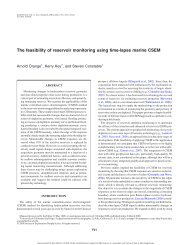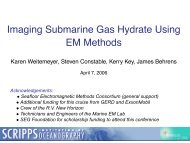MT <strong>Inversion</strong> <strong>for</strong> Resistivity Boundaries 83fact that the inverse problem becomes increasingly nonlinear<strong>with</strong> increasing roughness; thus, the Jacobian sensitivities arean inaccurate estimate <strong>of</strong> the gradient in the solution space.To obtain a better model, we split the inversion into severalsteps in which we sequentially lower the target χ 2 . At each step,we reach the target misfit and per<strong>for</strong>m several more iterationsto smooth the model further. This ensures that the startingmodel at each iteration is reasonably smooth, so that a globallysmooth model can be found. The best smoothed model wecould achieve has an rms misfit <strong>of</strong> <strong>of</strong> 1.15 and was reachedafter a total <strong>of</strong> 22 iterations.This model, shown in Figure 7, shows that both the resistivitiesand boundary locations are reasonably well recovered;the resistivity <strong>of</strong> the wedge is 74 ohm-m in this model, andthe overlying and underlying layers each have a resistivity <strong>of</strong>1 ohm-m. The blunt termination <strong>of</strong> the wedge at the left is accuratelyimaged, but the flattening out <strong>of</strong> the wedge at the rightis poorly imaged. Indeed, the <strong>data</strong> residuals indicate that thefit is poorest <strong>for</strong> the stations at the right.We applied the Occam inversion method to these <strong>data</strong>, <strong>with</strong>a target rms <strong>of</strong> 1.15; the model shown in Figure 8 was attainedafter nine iterations. Obviously, this model does not resemblethe model recovered from the boundary inversion method, althoughthe response yields an equal misfit to the <strong>data</strong>. This issymptomatic <strong>of</strong> the nonuniqueness inherent in the MT method.The fact that highly dissimilar models can yield equivalent responsesindicates that the model solution is highly dependenton the choice <strong>of</strong> norm imposed on the model <strong>with</strong>in the regularizationprocedure. It also indicates the importance <strong>of</strong> a reasonablechoice <strong>of</strong> starting model <strong>for</strong> the <strong>sharp</strong> boundary inversion.Thus, application <strong>of</strong> geologically realistic constraintsis particularly important <strong>for</strong> imaging resistive targets using theMT method.INVERSION OF REAL DATAA marine MT(MMT) survey was carried out in the Gulf <strong>of</strong>Mexico in 1997 to test the feasibility <strong>of</strong> using sea-floor MT <strong>data</strong>to image the base <strong>of</strong> salt <strong>structure</strong>s (Constable et al., 1998;Hoversten et al., 2000). Imaging these <strong>structure</strong>s is <strong>of</strong> interestto the petroleum industry as salt <strong>structure</strong>s are associated<strong>with</strong> hydrocarbon traps. The high acoustic contrast between saltbodies and the surrounding matrix makes it difficult and costlyto image the shape <strong>of</strong> these bodies seismically. On the otherhand, the high resistivity contrast between salt bodies and thesurrounding water-saturated sediments (salt bodies are highlyresistive) makes it a good target <strong>for</strong> MMT exploration.The 1997 MMT survey was conducted over the Gemini subsaltpetroleum prospect located at 28 ◦ 46 ′ N, 88 ◦ 36 ′ W. Its shapewas previously determined using 3D seismic prestack depth migration,along <strong>with</strong> depth constraints provided by well logs. Inthis section, we use the boundary inversion method to examinewhether MMT <strong>data</strong> can be used to independently constrain theshape <strong>of</strong> a salt body. Bathymetry along the transect consideredhere is minor; there is less than 200-m relief along the line. Furthermore,the skin depths in the conductive sea-floor sedimentsare small, so field distortions due to bathymetric variations arequickly dissipated. There<strong>for</strong>e, bathymetric corrections may beneglected in the following analysis.The Gemini salt <strong>structure</strong> is a 3D body; thus, the electric andmagnetic fields do not decouple into two modes, as they would<strong>for</strong> an ideal prism. The survey line was along a perpendicularto a subsection <strong>of</strong> this <strong>structure</strong> that is 3–4 times longer than itis wide, approximately along its middle. TM mode impedanceswere calculated using the electric (E) field perpendicular to thelong axis <strong>of</strong> the body (local strike) and magnetic (H) field parallelto the strike. Previous numerical modeling studies (e.g.,Wannamaker et al., 1984) show that the response <strong>for</strong> a centrallylocated pr<strong>of</strong>ile across an elongate 3D body agrees <strong>with</strong>the TM response <strong>for</strong> a <strong>2D</strong> body <strong>with</strong> identical cross-section.Thus, we invert the TM mode <strong>data</strong> to image the cross-section<strong>of</strong> the 3D body. The TM <strong>data</strong>, shown at left in Figure 9, arerelatively noisy. Error estimates <strong>for</strong> the apparent resistivitiesand phases are as high as 50%; the minimum error is taken tobe 10%. Data from 15 sites at an average spacing <strong>of</strong> 0.9 km areconsidered.FIG. 7. Model recovered from boundary location inversion <strong>of</strong><strong>data</strong> shown in Figure 6. The model is shown at 2:1 vertical exaggeration.The wedge boundaries are shown superimposed onthe model. The station locations are indicated by the trianglesat the top <strong>of</strong> the pr<strong>of</strong>ile.FIG. 8. Model recovered from smooth inversion <strong>of</strong> <strong>data</strong> shownin Figure 6. The model is shown at 2:1 vertical exaggeration.The wedge boundaries are shown superimposed on the model.The station locations are indicated by the triangles at the top<strong>of</strong> the pr<strong>of</strong>ile.
84 de Groot-Hedlin and ConstableWe started the inversion <strong>of</strong> these <strong>data</strong> <strong>with</strong> a best-fittingseven-layer model determined from a 1D inversion <strong>of</strong> the <strong>data</strong>.The resistivities and depths <strong>with</strong> respect to the sea floor as listedin Table 3. For the first several iterations, no penalty was appliedto resistivity contrasts between layers. A single layer waspinched out in the first iteration and the inversion was restarted<strong>with</strong> six units. After several iterations, the models feature largeconductivity contrasts between units, and the algorithm convergespoorly due to breakdowns in the linear approximations.There<strong>for</strong>e, the inversion was restarted <strong>with</strong> a small penalty appliedto differences between the resistivities <strong>of</strong> adjacent units[i.e., the value c in equation (3) is given a small nonzero value].The final model, attained after a total <strong>of</strong> 18 iterations has anrms misfit <strong>of</strong> 1.2 and is shown in Figure 10. The shape <strong>of</strong> the bodydetermined by 3D seismic prestack migration is shown superimposed.The model results indicate that the shape <strong>of</strong> the lowersalt boundary is quite well resolved. Further tests <strong>with</strong> otherstarting models confirmed that the shape <strong>of</strong> the salt <strong>structure</strong>is consistently recovered in the inversion <strong>for</strong> boundary depths;however, the resistivity <strong>of</strong> this <strong>structure</strong> is less well resolved.The salt resistivities recovered ranged from 10 to 100 ohm-m.The TM mode response <strong>of</strong> the model in Figure 10 is shown atright in Figure 9. Comparison <strong>with</strong> the original <strong>data</strong> indicatesthat the broad features <strong>of</strong> this noisy <strong>data</strong> set are reproduced;the resistive salt body is manifested as a “pull-up” <strong>of</strong> the lowresistivities in the middle <strong>of</strong> the TM resistivity <strong>data</strong>, and as anisolated region <strong>of</strong> low values in the phase <strong>data</strong>. Thin resistivelayers at 1 km below the sea floor to the northeast <strong>of</strong> the saltbody are not represented in the seismic model, but have beenconfirmed by controlled source EM sounding.For comparison, we inverted these <strong>data</strong> using the Occam inversion,<strong>with</strong> a target misfit <strong>of</strong> 1.2. The algorithm converged tothe model shown in Figure 11 in three iterations. The top <strong>of</strong> thesalt <strong>structure</strong> is reasonably well resolved by this smooth inversionmethod, but the bottom is very poorly resolved althoughthe residuals indicate that the broad features <strong>of</strong> the <strong>data</strong> areadequately recovered. These results indicate that a contrastin resistivities at the top <strong>of</strong> the salt boundary is required bythe <strong>data</strong>, but that little contrast is required at the bottomboundary at this misfit level. However, the existence <strong>of</strong> a <strong>sharp</strong>Table 3.Boundary depth(km)Starting model <strong>for</strong> inverting Gemini <strong>data</strong>.Resistivity(ohm-m)0.446 0.731.023 1.231.918 1.253.298 1.475.424 1.168.704 3.89half-space 5.96FIG. 10. Model recovered from boundary location inversion <strong>of</strong>the Gemini <strong>data</strong>. The shape <strong>of</strong> the salt body recovered from3D seismic prestack migration is shown superimposed on themodel. Station locations are indicated by the triangles at thetop <strong>of</strong> the pr<strong>of</strong>ile. The station locations are indicated by the trianglesat the top <strong>of</strong> the pr<strong>of</strong>ile.FIG. 9. Gemini <strong>data</strong>. (a) TM mode log 10(ρ a ) <strong>data</strong>. (b) Pseudosection<strong>of</strong> the response <strong>of</strong> the model shown in Figure 10log 10 (ρ a ). (c) TM mode phase <strong>data</strong>. (d) Pseudosection <strong>of</strong> theTM phase response <strong>of</strong> the model shown in Figure 10.FIG. 11. Model recovered from Occam inversion <strong>of</strong> Gemini<strong>data</strong>. The station locations are indicated by the triangles at thetop <strong>of</strong> the pr<strong>of</strong>ile.




